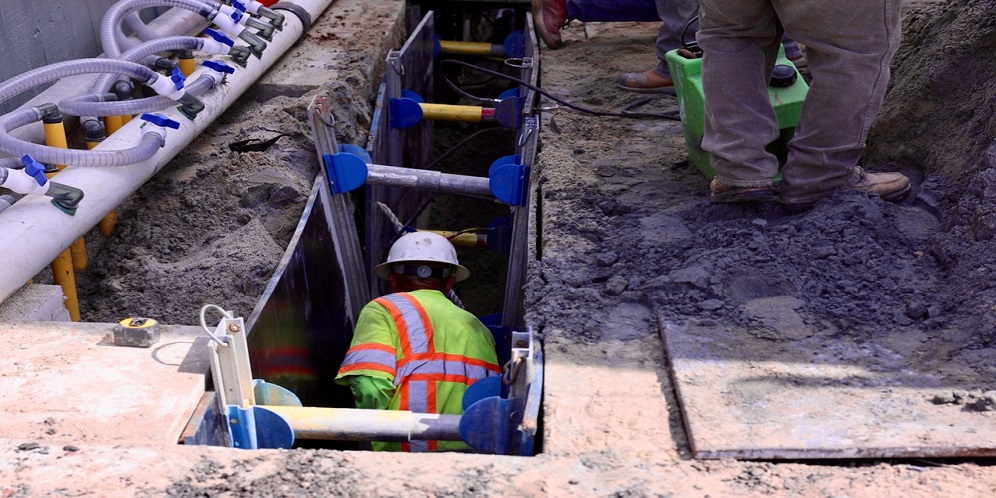When installing underground utilities, whether for water, gas, electrical cables, or telecommunications lines, the method you choose can significantly affect the overall success of your project. Among the most common methods are traditional trenching and horizontal directional drilling (HDD), which is more advanced. Each of these methods has advantages, challenges, and costs.
In this blog post, you will learn their differences to determine the right approach for your next underground construction project.
What is Directional Drilling?
Horizontal directional drilling (HDD) is an advanced form of drilling technology that enables underground utilities to be installed with minimal surface disruption. HDD uses a guided drill bit to create a horizontal bore beneath the surface, allowing utilities to be laid without the need for large-scale excavation.
In HDD, a small pilot hole is drilled at a specific angle, and then the hole is enlarged to the desired diameter using reamers. The utility lines are then pulled back through the bore. This method is part of the broader category of trenchless technology, which allows for installation without disturbing the earth’s surface.
Pros of Directional Drilling
- Non-Destructive: The key benefit of directional drilling is that it is non-destructive. The process minimises surface disruption in areas with sensitive environments like parks, rivers, or populated urban zones. It is used for non-destructive digging in Sydney to preserve valuable infrastructure and landscapes.
- Cost-Effective in the Long Run: While the upfront cost of HDD equipment may be higher, the savings in restoration, environmental impact mitigation, and disruption to businesses or residents can make it more cost-effective in the long run.
Cons of Directional Drilling
- Higher Initial Costs: The equipment used for horizontal directional drilling is more expensive than the machinery required for traditional trenching. The initial setup and operation can also require skilled labour, adding to the overall cost.
- Complexity in Rocky or Hard Soil: HDD is not always suitable for areas with hard rock or challenging soil conditions. In such cases, traditional trenching might be the better option.
What is Traditional Trenching?
Traditional trenching, also known as open trenching, is the method most people consider when they hear about digging for underground utilities. This technique involves excavating a trench through which the utility pipes or cables are laid. The process is straightforward and involves using heavy machinery, such as backhoes, bulldozers, or excavators, to dig a wide trench.
While this method is well-understood and frequently used, it can present several challenges depending on the location, type of utility being installed, and environmental factors.
Pros of Traditional Trenching
- Cost-Effective for Shallow Installations: If the utility needs to be installed relatively close to the surface, traditional trenching can be more affordable as it requires less sophisticated technology.
- Simplicity and Familiarity: Many construction teams are familiar with the process and equipment needed for open trenching, which can make the project execution smoother.
Cons of Traditional Trenching
- Disruptive to the Environment: Traditional trenching can disrupt the surrounding environment. Excavating large sections of the earth can damage roads, landscapes, and structures. Restoration of these areas can be costly and time-consuming.
- Traffic and Public Disruption: In urban areas, traditional trenching leads to major disruptions when roads need to be closed or rerouted for the digging process. This can affect local businesses, commuters, and residents.
Which Method Is Right for Your Project?
Choosing the right method depends on several factors, including the location of your project, the type of utility you need to install, your budget, and the timeline for completion. Below are some factors to consider when deciding between traditional trenching and horizontal directional drilling.
Location and Accessibility
- If your project is located in an urban area with a lot of infrastructure, such as roads, buildings, or other utilities, horizontal directional drilling is the better choice. HDD prevents you from digging up roads and sidewalks, saving time and money in the long term.
- In rural areas or open spaces where surface disruption is less of a concern, traditional trenching might be more appropriate if the underground utility installation is shallow and accessible.
Environmental Impact
- If your project involves sensitive environments, such as wetlands, parks, or areas of historical or cultural significance, directional drilling provides a far less intrusive installation method. It is an ideal solution for minimising environmental impact.
- Traditional trenching is far more disruptive to natural landscapes and may require significant restoration efforts.
Budget and Timeline
- While the initial cost of directional drilling may be higher, the reduced costs for restoration and road repairs and the ability to work under challenging environments can make it more economical for specific projects in the long run. HDD can be completed faster than traditional trenching in urban or congested areas.
- For projects on a tight budget or in locations where trenching is straightforward and doesn’t require a lot of restoration, traditional trenching may be the more affordable option.
Conclusion
Both traditional trenching and horizontal directional drilling have their place in utility installation and underground construction projects. If your goal is to minimise environmental disruption, reduce public inconvenience, and lower long-term costs,
Directional drilling is the best method. If your project is located in a more open area with minimal environmental concerns, traditional trenching may still be the most cost-effective solution.
The choice between these methods will depend on the specific project requirements, the location, the type of utility being installed, and the desired outcome. By evaluating all these factors, you can determine which method best fits your needs, ensuring a successful and efficient utility installation.
Directional Drilling Australia delivers reliable solutions for your complex projects. Don’t let obstacles delay your progress; our experienced team and innovative technology ensure optimal results. Call 0408335532 for a consultation and discover how we can streamline your operations.






